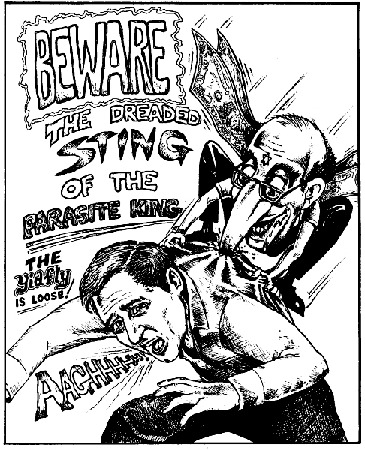
|
The ‘Anti-Semite’ SmearAn excerpt from THE SIX MILLION RECONSIDERED |
There are some who regard this kind of word-juggling as a peculiar talent of those mystical Zionists who are involved with the esoteric doctrines of Kabbalism. In these arcane and little-known affairs, letters and syllables take on a bizarre significance not found in any other tongue. “Occult” experts today declare that there are certain vocal sounds and calligraphic shapes that can be used to conjure up powerful reactions in the everyday world of phenomena. This supposedly is why Hebrew is the pre-eminent language of sorcery, just as the six-pointed Star of David on the Zionist flag is perhaps the most common symbol in the “black arts.”
Whatever the truth of all this may be – and science today is approaching closer to the long-derided “irrational” side of experience – there is no question of Zionist word wizardry in view of their success in making the ridiculous neologism “anti-Semitism” a powerful psychological weapon. Nothing is surprising in this fraud-ridden business: it is a fact that the “anti-Semitism” conceit was coined in a half-jocular way by a 19th century Jewish journalist named Wilhelm Marr. That Marr himself was “anti-Semitic” is only one more wrinkle in the swirl.
Most Zionists Are Not True Semites
But this peculiar war of words rises to a final pitch of bewilderment in the fact that the people who angrily fling the epithet “anti-Semite” in all directions are definitely not racial Semites themselves. This includes the great majority of the Zionist Jews who have seized lands held for thousands of years by Arabs in Palestine, in order to form the modern Israeli entity.
These so-called Jews are actually descendants of a Mongolian people from Central Asia, who adopted Judaism by conversion around 740 A.D. They have no lineal connexion with the Biblical Hebrews, and hence only a squatters’ claim to the crossroads of the Near East thousands of miles from where they originated. The name of this Oriental tribe is the Khazars and their history is extremely interesting. They are also known as Polish Jews or Russian Jews, and in Hebrew as Ashkenazim (from the Hebrew word for Germany). The descendants of the original Old Testament Jews of ancient Judas are called Sephardim or Spanish Jews, and there has been over the years considerable ill feeling between these two sectors. (See, for example, the recent books of Stephen Birmingham, Our Crowd and The Grandees.)
The Sephardics have always affected a social snobbery toward the Ashkenazim, but in approximately the past century and a half, the more forceful and numerous neo-Khazars have seized control of world Jewish affairs, largely through the financial activities of the Rothschilds and the half-dozen banking dynasties allied with them, in Europe and particularly in America. This is also the element that has provided the terrorist architects and present power structure of the Zionist seizure of Palestine.
Somehow, this extraordinary situation of the Semitic Palestinian people being overrun, slaughtered and finally driven out of their homeland by the non-Semitic “Russian Jew” Zionists of Khazar descent – who then trumpet to the world that opposers of this crime are “anti-Semitic” – begins to take on the proportions of a scenario in the contemporary “Theater of the Absurd.”
The prominent Jewish writer, Arthur Koestler, grapples with this tragicomic affair in his 1976 study of the Khazars entitled The Thirteenth Tribe. Pointing out that “the large majority of surviving Jews in the world is of Eastern European – and thus perhaps mainly Khazar – origin,” he correctly observes that this logically makes the term anti-Semitism “void of meaning.” With huge understatement, Koestler declares that “the story of the Khazar Empire, as it slowly emerges from the past, begins to look like the most cruel hoax which history has ever perpetrated.” We would only quibble on one point: the hoax was not perpetrated by history.
Some Final Questions on ‘Anti-Semitism’
In closing this short inquiry, three questions come to mind.
- Since being branded an “anti-Semite” has become quite a stigma, placing in jeopardy the individual’s economic and social welfare, should not the phrase be exactly and rationally defined? Inevitably someone is going to be mislabeled sometime. And yet the arch-Zionist Anti-Defamation League of Banai B’rith, which usually has charge of wielding the branding iron, has repeatedly refused to answer queries from this committee asking for such a definition. We have sadly concluded by wondering whether that “upright” organization should not more accurately be called the Anti-Definition League!
- What is a “Semite”? Is it or is it not a member of a racial group? According to the prevailing Jewish authority, Jewry is a religious group only, with no racial (i.e., genetic) identity. Yet they continue tacitly to endorse a 19th century racialist conception of themselves every time they label an opponent “anti-Semitic.” In order to get United Nations approval of a measure condemning religious discrimination recently, the so-called State of Israel gravely assented to having the word “anti-Jewish” substituted for “anti-Semitic.” If the two are synonymous to any extent, would it not be more accurate if all Jewish organizations similarly dropped the meaningless and racist designation “anti-Semitic” in favor of “anti-Jewish”?
- As we have seen, the majority of today’s Jews are not descendants of the Old Testament Hebrews but of a Mongolian people of Central Asia called Khazars. These people were fairly recent converts to Judaism, as Arthur Koestler and earlier writers have shown. Yet, the non-Semitic Mongolian “Jews” are by far the most powerful in Jewish and Zionist affairs, and are the ones who quickest raise the cry of “anti-Semitism” against ideas or activities that irritate them. In the interest of historical accuracy, should not this peculiar but evidently necessary vocabulary of swear-words be enriched by the term “anti-Khazar”? At the very least, should not intelligent people realize that anti-Zionism does not equal “anti-Semitism”?
The Six Million Reconsidered, Committee for Truth in History, Historical Review Press (1979), pp. 12-13.